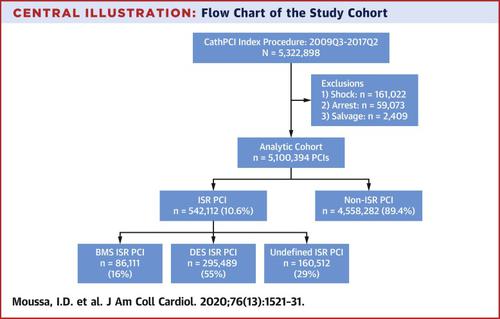当前位置:
X-MOL 学术
›
J. Am. Coll. Cardiol.
›
论文详情
Our official English website, www.x-mol.net, welcomes your
feedback! (Note: you will need to create a separate account there.)
Trends and Outcomes of Restenosis After Coronary Stent Implantation in the United States
Journal of the American College of Cardiology ( IF 21.7 ) Pub Date : 2020-09-01 , DOI: 10.1016/j.jacc.2020.08.002 Issam D Moussa 1 , Divyanshu Mohananey 2 , Jorge Saucedo 2 , Gregg W Stone 3 , Robert W Yeh 4 , Kevin F Kennedy 5 , Ron Waksman 6 , Paul Teirstein 7 , Jeffrey W Moses 8 , Chuck Simonton 9
Journal of the American College of Cardiology ( IF 21.7 ) Pub Date : 2020-09-01 , DOI: 10.1016/j.jacc.2020.08.002 Issam D Moussa 1 , Divyanshu Mohananey 2 , Jorge Saucedo 2 , Gregg W Stone 3 , Robert W Yeh 4 , Kevin F Kennedy 5 , Ron Waksman 6 , Paul Teirstein 7 , Jeffrey W Moses 8 , Chuck Simonton 9
Affiliation

|
BACKGROUND
There is a paucity of data on the burden of in-stent restenosis (ISR) in the United States as well as on its presentation and appropriate treatment strategies. OBJECTIVES
This study aims to provide an analysis of the temporal trends, clinical presentation, treatment strategies, and in-hospital outcomes of patients undergoing percutaneous coronary intervention (PCI) for ISR in the United States. METHODS
This study is a retrospective analysis of data collected in the Diagnostic Catheterization and Percutaneous Coronary Intervention (CathPCI) registry of the National Cardiovascular Data Registry (NCDR) between 2009 and 2017. Of the total patients undergoing PCI, we identified those undergoing PCI for ISR lesions. For comparison of in-hospital outcomes, propensity-score matching was employed. RESULTS
Among the 5,100,394 patients undergoing PCI, 10.6% of patients underwent PCI for ISR lesions. Patients with bare-metal stent ISR declined from 2.6% in 2009 Q3 to 0.9% in 2017 Q2 (p < 0.001), and drug-eluting stent ISR rose from 5.4% in 2009 Q3 to 6.3% in 2017 Q2 (p < 0.001). Patients with ISR PCI were less likely to present with non-ST-segment elevation myocardial infarction (MI) (18.7% vs. 22.5%; p < 0.001) or ST-segment elevation MI (8.5% vs. 15.7%; p < 0.001). In the propensity-matched population of patients, there were no significant differences between patients with ISR and non-ISR PCI for in-hospital complications and hospital length of stay. CONCLUSIONS
ISR represents approximately 10% of all PCI and is treated most commonly with another stent. Approximately 25% of patients present with acute MI. In-hospital outcomes of patients with ISR PCI are comparable with those undergoing non-ISR PCI.
中文翻译:

美国冠状动脉支架植入术后再狭窄的趋势和结果
背景 在美国,关于支架内再狭窄 (ISR) 负担及其表现和适当治疗策略的数据很少。目的 本研究旨在分析美国接受经皮冠状动脉介入治疗 (PCI) 治疗 ISR 的患者的时间趋势、临床表现、治疗策略和住院结果。方法 本研究是对 2009 年至 2017 年国家心血管数据登记处 (NCDR) 的诊断导管和经皮冠状动脉介入 (CathPCI) 登记处收集的数据的回顾性分析。病变。为了比较住院结果,采用倾向评分匹配。结果 在 5,100 人中,394 名患者接受 PCI,10.6% 的患者因 ISR 病变接受 PCI。裸金属支架患者 ISR 从 2009 年第三季度的 2.6% 下降到 2017 年第二季度的 0.9%(p < 0.001),药物洗脱支架 ISR 从 2009 年第三季度的 5.4% 上升到 2017 年第二季度的 6.3%(p < 0.001) . ISR PCI 患者出现非 ST 段抬高心肌梗死 (MI)(18.7% 对 22.5%;p < 0.001)或 ST 段抬高 MI(8.5% 对 15.7%;p < 0.001)的可能性较小)。在倾向匹配的患者人群中,ISR 和非 ISR PCI 患者的院内并发症和住院时间没有显着差异。结论 ISR 约占所有 PCI 的 10%,最常使用另一种支架治疗。大约 25% 的患者出现急性 MI。
更新日期:2020-09-01
中文翻译:

美国冠状动脉支架植入术后再狭窄的趋势和结果
背景 在美国,关于支架内再狭窄 (ISR) 负担及其表现和适当治疗策略的数据很少。目的 本研究旨在分析美国接受经皮冠状动脉介入治疗 (PCI) 治疗 ISR 的患者的时间趋势、临床表现、治疗策略和住院结果。方法 本研究是对 2009 年至 2017 年国家心血管数据登记处 (NCDR) 的诊断导管和经皮冠状动脉介入 (CathPCI) 登记处收集的数据的回顾性分析。病变。为了比较住院结果,采用倾向评分匹配。结果 在 5,100 人中,394 名患者接受 PCI,10.6% 的患者因 ISR 病变接受 PCI。裸金属支架患者 ISR 从 2009 年第三季度的 2.6% 下降到 2017 年第二季度的 0.9%(p < 0.001),药物洗脱支架 ISR 从 2009 年第三季度的 5.4% 上升到 2017 年第二季度的 6.3%(p < 0.001) . ISR PCI 患者出现非 ST 段抬高心肌梗死 (MI)(18.7% 对 22.5%;p < 0.001)或 ST 段抬高 MI(8.5% 对 15.7%;p < 0.001)的可能性较小)。在倾向匹配的患者人群中,ISR 和非 ISR PCI 患者的院内并发症和住院时间没有显着差异。结论 ISR 约占所有 PCI 的 10%,最常使用另一种支架治疗。大约 25% 的患者出现急性 MI。











































 京公网安备 11010802027423号
京公网安备 11010802027423号